Illuminated
Encounters and Erotic Duties in the Life and Art
of Maria Beatty
by Katrien Jacobs
"You are dreaming," she cried. "Wake up!" She grasped my arm with her marble hand. "Wake up" she repeated, this time in a low, gruff voice. --von Sacher-Masoch
Pain is as capable, perhaps more so, of inscribing bodies as pleasure. --Elizabeth Grosz
The Nostalgic Habitat: Versailles
From Elegant to Cold Masochism
The Nostalgic Habitat: Versailles
You may enter this space not finding anything in particular to remind you of the sex act: no unmade beds, no posing bodies, no pastel lights. You have taken a dark elevator and walked into the gracious decor of one of New York City’s most refined s/m houses. You encounter blue velvet-covered walls which open and close like sliding doors and regulate an ongoing traffic of clients who want to visit the different rooms: the dungeon, the medical room, the classroom, Times Square, the virtual reality room, and Versailles. This last one is an ostentatious anteroom for visitors who want to initiate theater pieces in faux aristocratic environments furnished with fireplaces, marble statues, gilt frames, and brocaded thrones. Versailles casts an illusion of tactile organization and orderliness in the heart of a congested metropolis. To the uninformed outsider, the stage setup of Versailles evokes the stifling code of conduct of the upper-class. To the s/m practitioner, however, this master-servant space houses a protocol of subterfuge and erotic cruelty. Looking at the variety of performances and fantasies enacted in Versailles (and its hidden dungeons) "sadomasochism" becomes a polymorphous body of sex acts which deviate from straight, genital-oriented, plotless intercourse --spanking, gagging, body piercing, urinating, infantilism, cross-dressing. The dominant and submissive partners engage in role-play and transform the bedroom ritual into a "holistic" event which purposefully moderates, and artfully interrupts, the goal of sexual intercourse and/or reproduction.
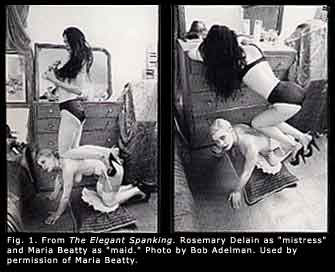 "Versailles,"
as a setting for treacherous upper class rituals and status symbols, provides
the framework for the early pornographic film art of Maria Beatty. (FIG.1)
As a literary reference and ideological statement, Beatty’s work
pays tribute to Jean Genet and his play The Balcony (1958) which
anticipated the s/m subculture’s growing desire to shatter myths
of paternal authority. In the play, "staged" types of eroticism become
the equivalent of a symbolic castration. The satirical and erotic evocation
of authority figures such as the Judge, the Bishop, the General, and the
Police, are juxtaposed with the "egalitarian" views of a political revolutionary,
Roger, who represents,"the real world outside." In the final scene of
the play, at the height of a Paris revolution, Roger undergoes an identity
crisis and goes to the s/m house to (clumsily) act out a Chief of Police
in the vicinity of an obeying "slave." Roger then castrates himself in
a paradoxical attempt to impersonate and annihilate his desire for power.
Roger is thrown out of the s/m house by the proprietress, Madame Irma,
who disdains his lack of performative rigor and his lunatic gesture of
self-mutilation which also stains her new carpets.
"Versailles,"
as a setting for treacherous upper class rituals and status symbols, provides
the framework for the early pornographic film art of Maria Beatty. (FIG.1)
As a literary reference and ideological statement, Beatty’s work
pays tribute to Jean Genet and his play The Balcony (1958) which
anticipated the s/m subculture’s growing desire to shatter myths
of paternal authority. In the play, "staged" types of eroticism become
the equivalent of a symbolic castration. The satirical and erotic evocation
of authority figures such as the Judge, the Bishop, the General, and the
Police, are juxtaposed with the "egalitarian" views of a political revolutionary,
Roger, who represents,"the real world outside." In the final scene of
the play, at the height of a Paris revolution, Roger undergoes an identity
crisis and goes to the s/m house to (clumsily) act out a Chief of Police
in the vicinity of an obeying "slave." Roger then castrates himself in
a paradoxical attempt to impersonate and annihilate his desire for power.
Roger is thrown out of the s/m house by the proprietress, Madame Irma,
who disdains his lack of performative rigor and his lunatic gesture of
self-mutilation which also stains her new carpets.
Genet’s anarchic/fatalistic scenario presents Roger’s tragedy as the dramatic epiphany of a wavering modern psyche. A new dimensionality in Roger’s identity emerges through his simultaneous impersonation and castration of authority. As Roger is forced to shape and grow into the world of gendered performance and state institutions, sexual and revolution ary activity can only be obtained through erotic and regressive reversals of identity. Genet thus presents castration as tantamount to a rejection of an oppressive, genital-oriented culture and an affirmation of childhood’s sexually undifferentiated state.
Recasting Genet’s
master/servant narrative, Beatty’s trompe l'oeil scenery further
explodes gender binaries and moves art inside the frame of screen pornography
and radical sex politics. Beatty’s debut film The Elegant
Spanking (1995) portrays a childhood memory and longing for mother-daughter
gratification. The film uses a classical spanking setting of s/m pornography,
and builds towards the gradual display of naked buttocks, meticulous spankings
carried out by a lady’s hand, and sexual climax. Punishment and spanking
refer back to childhood, yet are acted out as a gentle lesbian perversity.
Beatty dresses up as a French maid 'Kitty' and stages an illuminated
encounter with her aristocratic mistress/girlfriend --Goddess Rosemary
(Rosemary Delain).(FIG.2)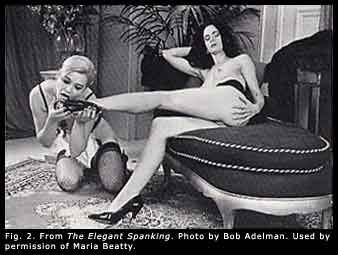 Kitty is a little, naughty woman who desires to be touched by the maternal
mistress and fantasizes contact with her bodily fluids: "To sip from
her tea-cup. To Lick her feet. To drink her urine.
Kitty is a little, naughty woman who desires to be touched by the maternal
mistress and fantasizes contact with her bodily fluids: "To sip from
her tea-cup. To Lick her feet. To drink her urine.
To taste the dirt from her water of life. 'Kitty’s' eyes are those dark-edged eyes of the silent movies. They slowly pace the movie and beg for the silent action to take place. The viewer becomes part of what she sees: the physical contours of a stern mistress who is narcissistic and punishes her for showing signs of jealousy. The little woman, submissive in the s/m scenario, functions as a voyeur and Magister Ludi or unseen director of the film action. Beatty develops a classical, stylized mis-en-scene which follows 'Kitty’s' point of view shot --i.e. her gaze which contemplates old-fashioned china and roses, spiked heels and suspender corsets, and fetishistic genital shots. Once Kitty gets punished, and her bare buttocks (rather than her eyes) become the focal point of the movie, The Elegant Spanking starts revealing its pornographic intent to the viewer. It takes the viewer on a climactic ride in experiencing fetishism and foot worship, mutual masturbation, spanking scenes, and a golden shower.
In a daringly explored tension between classical film composition and assertive bodily display, The Elegant Spanking offers a new contribution to lesbian s/m porn. A romantic-nostalgic filmmaker, Beatty pays tribute to the stage setup of Versailles, yet she also forces the film to gradually unfold its illusionistic cachet. The Elegant Spanking thus develops from a crisply proceeding dialectic between nostalgic and factual s/m desire. Nostalgic desire frames the scripted and fictionalized narrative of the past; while the unscripted and unspoken narrative reveals a unique relationship and physical desire between Beatty and Delain.
The stylized acting makes reference to older experiments in film art such as the surrealist film, while the lesbian imagery recalls a history of pornographic cinematic imagination. Beatty’s well crafted "butt" compositions in particular, hearken back to underground pornography and the birth of audio-visual technology in the 19th century. A catalog of Nazarieff's collection Jeux de Dames Cruelles Photographies 1850-1960 (1992) shows lesbian spanking scenes which have been integral to the institution of photography since the mid-19th century. Most pictures zoom in on the naked, submissive "girlish" butt cheeks as fetishized body parts. The two glaring cheeks surrounded by black stockings and white lace petticoats are an expressionistic black and white contrast which features strongly in The Elegant Spanking. The classroom punishment and mistress-maid scenes, staged by male photographers for male pleasure, mostly depict the dominatrix participant as an older, uptight woman; while the submissive is a young and beautiful "little" woman. The age contrast between the two participants reaffirms the mimetic character of the punishment scenes and hides their pornographic intent. As we browse through Nazarieff's collection and enter the more recent photographs, we see a break-down of mimetic illusionism and the emergence of desire in the dominant and submissive partners--facial expressions of laughter, a joyful surrender to the photographer’s fantasy. (FIG.3,4,9)
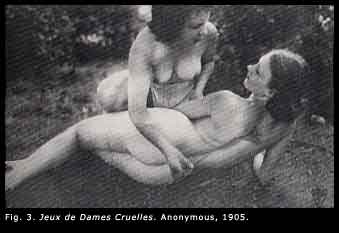 As
new lesbian porn, The Elegant Spanking radically rewrites the traditional
contract between male producer and female actress. Beatty’s nostalgic
gaze revisits the old-day punishment scenes, yet it also shows how
mistress and maid can collaborate delicately in reaching intimate physical
contact, mutual satisfaction and orgasm. Beatty reorganizes age divisions
and encourages young women to receive and produce pleasure within the
s/m industry. Rosemary Delain appropriates the royal throne of Versailles
in order to implement a punishment fantasy which provides pleasure and
desire in both the dominant and submissive partners. In its most humorous
aspect, The Elegant Spanking illustrates how the spanking narrative
can be hijacked and appropriated by young women who want to court their
partners and make kinky sex portraits.
As
new lesbian porn, The Elegant Spanking radically rewrites the traditional
contract between male producer and female actress. Beatty’s nostalgic
gaze revisits the old-day punishment scenes, yet it also shows how
mistress and maid can collaborate delicately in reaching intimate physical
contact, mutual satisfaction and orgasm. Beatty reorganizes age divisions
and encourages young women to receive and produce pleasure within the
s/m industry. Rosemary Delain appropriates the royal throne of Versailles
in order to implement a punishment fantasy which provides pleasure and
desire in both the dominant and submissive partners. In its most humorous
aspect, The Elegant Spanking illustrates how the spanking narrative
can be hijacked and appropriated by young women who want to court their
partners and make kinky sex portraits.
How can we zoom
closer into such artful "little death" scenes conceived by two women at
the fringes of the porn industry? Whereas sexual flagellation has for
centuries been recognized by the industries of sex, medicine, and pornography,
as a healthy instrument of erotic stimulation, its healing aspects have
been mostly reserved for men. In the 17th century, German doctor Johan
Heinrich Meibaum (1590-1655) wrote the first in a series of influential
treatises about the medical benefits of sexual flagellation, indicating
that it cured the adult male subject of madness, melancholy caused by
unhappy love, erotic mania, skinniness, bodily weakness, but above all
impotence. (FIG.5) 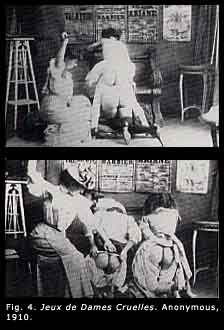 This
idea became institutionalized in the prostitution house, were male patients
would be sent out to be spanked or "cured" by a female dominant.
Ian Gibson's study The English Vice: Beating, Sex, Shame in Victorian
England and After further documents spanking stories which featured
regularly in the British newspapers as a form of hidden pornography. Needless
to say that women, often portrayed as dominant characters within the fantasies,
were actually discouraged from advertising erotic fantasies in newspapers
or public s/m houses. Female spanking perverts were still mostly a male
invention. Take for instance John Cleland’s porn classic Memoirs
of Fanny Hill (1749) which narrates a challenging encounter between
Fanny and the young, impotent Mr.Barville. Cleland details the whipping
session and conveys how Fanny herself gets pleasantly aroused. After mutual
spanking and a nice dinner with Mr. Barville, Fanny is suddenly overcome
by "itching ardors" and "a prickly heat" which makes her
shift and wriggle in her seat. Finally, Mr.Barville helps her get full
satisfaction by means of spanking and intercourse. Published in the 1920s
in Victorian England, Havelock Ellis's case-study "Florrie," narrated
the life of a suffragette who pursued feminism in public life and begged
for chastisement and confinement in private life. Ellis as an early psycho-analyst
taught Florrie how to accept her fantasies and gradually encouraged her
to have her first orgasm through flaggelation. A fully self-authored and
persistent spanking fanatic was Edith Cadivec who wrote her memoirs in
Confessions and Experiences and Eros,the Meaning of My Life
(1920-1924). Cadivec gave an explicit account of her masochism and explained
it as a cry for the intense physical touch and affection of her mother
who passed away when she was nine years old.
This
idea became institutionalized in the prostitution house, were male patients
would be sent out to be spanked or "cured" by a female dominant.
Ian Gibson's study The English Vice: Beating, Sex, Shame in Victorian
England and After further documents spanking stories which featured
regularly in the British newspapers as a form of hidden pornography. Needless
to say that women, often portrayed as dominant characters within the fantasies,
were actually discouraged from advertising erotic fantasies in newspapers
or public s/m houses. Female spanking perverts were still mostly a male
invention. Take for instance John Cleland’s porn classic Memoirs
of Fanny Hill (1749) which narrates a challenging encounter between
Fanny and the young, impotent Mr.Barville. Cleland details the whipping
session and conveys how Fanny herself gets pleasantly aroused. After mutual
spanking and a nice dinner with Mr. Barville, Fanny is suddenly overcome
by "itching ardors" and "a prickly heat" which makes her
shift and wriggle in her seat. Finally, Mr.Barville helps her get full
satisfaction by means of spanking and intercourse. Published in the 1920s
in Victorian England, Havelock Ellis's case-study "Florrie," narrated
the life of a suffragette who pursued feminism in public life and begged
for chastisement and confinement in private life. Ellis as an early psycho-analyst
taught Florrie how to accept her fantasies and gradually encouraged her
to have her first orgasm through flaggelation. A fully self-authored and
persistent spanking fanatic was Edith Cadivec who wrote her memoirs in
Confessions and Experiences and Eros,the Meaning of My Life
(1920-1924). Cadivec gave an explicit account of her masochism and explained
it as a cry for the intense physical touch and affection of her mother
who passed away when she was nine years old.
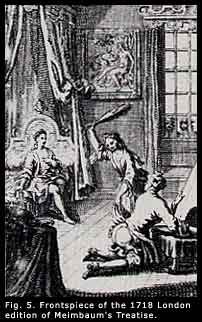 In
order to understand the female "submissive" personae from Cadivec to Beatty;
we have to remember that women pornographers have been thoroughly misapprehended
and censored by print and non-print publishers. How can we even start
to unfold the motives behind their cautiously hidden or blatantly maimed
narratives? Pornography as a legal term denoting selected and censored
publications emerged "...in the context of the careful regulation of the
consumption of the obscene so as to exclude the lower classes and women."
In her study The Invention of Pornography, Lynn Hunt argues
that pornography has since its emergence had a paradoxical relationship
to democracy. It was "invented" in modernity (1500-1800) in response to
the perceived menace of the democratization of culture through forms of
mass communication. To the present day, it has been a challenge for women
and other minorities to become directors and critics of pornography, and/or
public agents of sexual pleasure. Although the institution of s/m has
become more available to women in straight and lesbian relationships,
the female submissive persona has been scarcely analyzed and touched upon
by critics and theorists of pornography.
In
order to understand the female "submissive" personae from Cadivec to Beatty;
we have to remember that women pornographers have been thoroughly misapprehended
and censored by print and non-print publishers. How can we even start
to unfold the motives behind their cautiously hidden or blatantly maimed
narratives? Pornography as a legal term denoting selected and censored
publications emerged "...in the context of the careful regulation of the
consumption of the obscene so as to exclude the lower classes and women."
In her study The Invention of Pornography, Lynn Hunt argues
that pornography has since its emergence had a paradoxical relationship
to democracy. It was "invented" in modernity (1500-1800) in response to
the perceived menace of the democratization of culture through forms of
mass communication. To the present day, it has been a challenge for women
and other minorities to become directors and critics of pornography, and/or
public agents of sexual pleasure. Although the institution of s/m has
become more available to women in straight and lesbian relationships,
the female submissive persona has been scarcely analyzed and touched upon
by critics and theorists of pornography.
Analyzing Beatty's s/m pornography means penetrating a complex interplay between staged submission and affluent desire, between postponed and actualized varieties of "little death." Art and reality are inescapably intertwined in her work environment, and the films function as a visual diary to her sexual development. When she started to produce The Elegant Spanking in 1994, Beatty had only barely developed her submissive alter ego and she cleverly used film technology to formulate the new identity. Her "fame" in the New York video art scene was growing at a steady pace, yet her s/m love relationships were fresh and sparkling. Although The Elegant Spanking grew out of a collaboration between Beatty and Delain, Beatty was in charge of most aesthetic aspects of the film making process, imposing composition and editing styles onto the spanking narrative. Once The Elegant Spanking was launched into the New York s/m scene and gay and lesbian film festival circuits, it caused exaltation, raving successes and emotional turbulence in the life of the producers.
During the premiere
screening of The Elegant Spanking at the University of Maryland
at College Park (March 1994, spanking and mutual masturbation scenes were
screened and acted out in front of a startled audience. Posters
and flyers were distributed all over the university’s campus to announce
the "coming" of Maria Beatty & Rosemary Detain. The s/m couple was
featured to show film clips and perform a live s/m session on an antique
chair. The antique chair was placed inside a university aula and was meant
to (humorously) destabilize quotidian power dynamics between professors
and students. Just like the "Versailles" environment of The elegant
Spanking, the chair functioned as a subversive nostalgic object
from which the law of the university could be challenged and eroticized.
The posters for the event showed a photograph of Beatty/Kitty kneeling
down to caress and worship the feet of her mistress. Still-photographs
from Beatty's production Sluts/Goddesses. How To Be a Sex Goddess in
101 Easy Steps (1993) depicted porn stars such as Annie Sprinkle,
Scarlet Harlot, and others showing their leather-strapped behinds and
dancing in bare-breasted rituals. In the lower left corner of the poster
the audience was invited to "come on down and join the transformation
facilitators in their quest for ecstasy and humor and their abrupt intrusion
into the narrow American mind." Unfortunately, several days before Beatty
and Delain arrived at the University of Maryland, all "Sex, Truth &
Videotapes" posters had been torn from public walls, doors and bulletin
boards. The poster design had caused a big stir on campus, offended conservative,
homophobic and anti-porn activists, and lured a large number of students
into attending the show.(FIG.6)
Regardless of the havoc in a conservative heartland, Beatty and Delain
performed their session and entertained the crowd with their passionate
consensual role-play and porn activism. 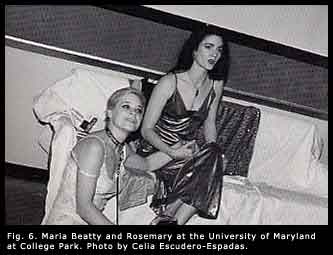 Although
they showed signs of erotic stimulation and sexual climax throughout the
performance, they were scarcely able to break out of their roles after
the session had ended. The question-and-answer session and interviews
which followed the event were unilaterally dominated by the mistress.
Beatty was punished and pushed next to the chair with a tug of Delain’s
leash, and did not get much of an opportunity to explain her motives for
directing this lesbian s/m film. Delain’s charismatic appearance
and discourse complemented her one-sided stock character in the film,
yet she also obliterated Beatty’s contribution to the event. However,
in order to analyze Beatty’s silent revenge and subterfuge within
the s/m mimetic film text, we have to further outline the agency of her
gaze and how it sets the parameters for demonstrative dominatrix behavior.
Although
they showed signs of erotic stimulation and sexual climax throughout the
performance, they were scarcely able to break out of their roles after
the session had ended. The question-and-answer session and interviews
which followed the event were unilaterally dominated by the mistress.
Beatty was punished and pushed next to the chair with a tug of Delain’s
leash, and did not get much of an opportunity to explain her motives for
directing this lesbian s/m film. Delain’s charismatic appearance
and discourse complemented her one-sided stock character in the film,
yet she also obliterated Beatty’s contribution to the event. However,
in order to analyze Beatty’s silent revenge and subterfuge within
the s/m mimetic film text, we have to further outline the agency of her
gaze and how it sets the parameters for demonstrative dominatrix behavior.
From Elegant to Cold Masochism
In her most recent
film The Black Glove (1996), Beatty documents a more fictional,
less "life-style" and experimental collaboration between s/m practitioners.
Beatty moves her persona inside a secluded space and writes a solipsistic
narrative which leads to the torture of the breasts and vagina. The film
opens with a stylized slow motion sequence showing lady-like stiletto
heels tapping into a polished floor. Beatty, tied up from head to heel,
is then delivered to the executioner’s room inside a soft velvet
wrapping. The psychological fantasy realm of The Black Glove
still resembles The Elegant Spanking: Beatty’s infantile longing
for maternal touch is translated and aestheticized into consensual lesbian
role-play. A young, helpless victim in disguise; Beatty’s soft and
infantile body craves to be violently matured by the mistress's masquerade.
However, the film soon shifts from a fetishistic shot revealing the mistress
to the representations of the victim's internalized gaze. The two central
mistresses in The Black Glove, Morgana and TV (transvestite) Sabrina,
are figments of Beatty's imagination. There are no more signs of intimacy
or human contact between the dominant and submissive partners. Morgana
looks like a cold and distant 'Pierrot' character and is an agent removed
from stage developments. Resembling Luis Bunuel’s surrealist actors
in Un Chien Andalou (1929), these technicians of erotic cruelty
embody the existentialist premise that they can only perceive reality
through the distorted lens of their consciousness. (FIG.7)
Beatty’s gaze in particular is no longer explicitly geared towards
"the maternal other," but brackets the other into the realm of private
desires. The bodily worship of The Elegant Spanking has been replaced
by a stainless steel fetish, a shining pinwheel and surgeon’s hemostats
which are slowly applied to Beatty’s body. Before she deprives herself
of all sensory perception by donning a black mask, black lace panties
(her own) are stuffed into her mouth. The camera then zooms into her vagina,
and her white labia are slowly pulled apart by means of shining instruments,
then to be covered with black candle wax. Towards the very end of the
film, a woman’s hand with black velvet glove enters the
picture and tempers the cruelty. This absent third player appears as a
shadow on the submissive's body, and her voice fills the soundtrack with
siren-like humming and orgasmic sounds. The contrast between soothing
nature sounds and imagery, and candid portrayals of bodily torture, is
crucial to Beatty's works. It is explained by the artist as an attempt
to show a painful state of bliss, or the bodily ecstasy (little death)
following sexual climax. (FIG.8)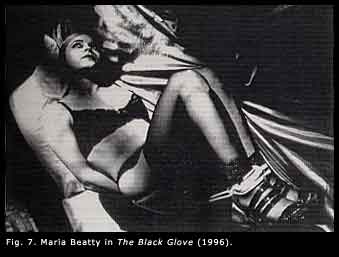
In order to trace Beatty’s development from nostalgic-romantic towards masochistic artist, we have to consider Gilles Deleuze’s study Masochism. An Interpretation of Coldness and Cruelty (1971). Deleuze's analysis of Von Sacher-Masoch's Venus in Furs can be applied to Beatty's art to reveal the transition she makes from life-style art to the more formal films. Following Freud in Beyond the Pleasure Principle, Deleuze explains that masochism, death or destructive instincts are exhibited in the unconscious in conjunction with life instincts. Destruction, and the negative at work in destruction, always manifests itself as the other face of construction and unification as governed by the pleasure-principle. Deleuze believes that the "negative" in masochism strives towards a "positive" outlet or "redeeming" cycle. Redemption is established through an intense physical ordeal which intensifies sense-perceptions and transforms them into distorted "formal" entities. In this respect, the masochistic gaze envisions a de-humanized sexual experience, or at least explores the tension between bodily sensations and the body as a representation. Deleuze concludes that there is a fundamentally cruel aesthetic or plastic element in masochism in its "freeze-framing" of aspects of reality.
Deleuze's second important insight is that masochistic fantasies are quite different from sadistic ones. Somehow, he considers masochistic fantasies to be more refined (or more subject to his theory). Whereas sadist performers act out the death instinct in demonstrative forms, by multiplying and condensing cruelty; masochists use a more contemplative method. Deleuze outlines how masochists use the gaze and contemplation to subvert law and authority. Deleuze's distinction between masochism and sadism is useful to understand Beatty's progress as an artist. As we have seen before, The Elegant Spanking subverts the law by featuring a young, lesbian couple occupying the space of authority, by showing how punishment and flagellation can nurture lesbian desire; and lastly, by showing a continuity between between s/m mimesis and relationship dynamics. These three aspects of subversion motivated the public appearance of Beatty and Delain at the University of Maryland. Deleuze would believe that such demonstrative subversions of the law are more typical of the sadist than the masochist. Masochistic fantasies, as he writes, twist the law "...by excess of zeal. By scrupulously applying the law we are able to demonstrate its absurdity and provoke the very disorder that it is intended to prevent or conjure." With The Black Glove, Beatty sinks deeper into the masochistic model of subversion. First of all, the film features an exaggerated, and slightly ridiculed, state of submission to fetishism, coldness, and cruelty. The masochistic content is also portrayed as a state of mind rather than a reality. The submissive’s "other" is no longer a living partner but an abstract formal entity. While Beatty still entertains the mysterious countenance of the mistresses, the film no longer confronts the presence, the living women's aura and relationship pangs, as did The Elegant Spanking.
Reading the diaries of von Sacher-Masoch, Deleuze takes notice of the baron’s austere sense perceptions, and how they infringe law and order upon the living environment:
It has been said that the senses become "theoreticians" and that the eye, for example, becomes a human eye when its object itself has been transformed into a human or cultural object, fashioned by and intended solely for man. Animal nature is profoundly hurt when this transformation of its organs from the animal to the human takes place, and it is this painful process that the art of Masoch came to represent.
Before Masoch pledges to surrender his life and luxury to the whims of a Russian mistress, he reclines in a comfortable chair and exposes the senses as "cruel theoreticians" to objects of the decadent environment. Masoch dissects the environment and tries to give up the distinction between bodily sensations and the art of fantasy. He calls this cultural state of transmuted sensualism, "super-sensualism," and he finds in inanimate works of art the reflection of his love for women who resemble cold, marble statues or paintings in darkened rooms. Although Masoch falls in love eventually and expects to be utterly mistreated by his mistress Wanda, he makes a first cruel leap between physical s/m personas and their disembodied reflections.
Through a process of "disavowal" of living, organic aspects of sexuality; masochists aestheticize physicality and create two-dimensional images as fetishes. As Deleuze writes:
The fetish is therefore not a symbol at all, but as it were a frozen, arrested, two-dimensional image, a photograph to which one return repeatedly to exorcise the dangerous consequences of movement, the harmful discoveries that result from exploration.
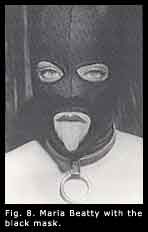 Here
we can see the most powerful connection between Masoch and Beatty --the
gaze which initiates the process of performing painful sexuality and becomes
the ultimate incarnation of a "formal" aesthetic experience. (FIG.10)
Materially speaking, Masoch gives up his estate to become a servant, laborer,
and slave to Wanda’s court; only to be further mistreated, humiliated
and finally "dumped" by the Russian empress. Beatty accepts
public punishment from her mistress in a front of film audiences, and
uses a slave psychology to make fetishistic film portraits of the mistress's
body parts.
Here
we can see the most powerful connection between Masoch and Beatty --the
gaze which initiates the process of performing painful sexuality and becomes
the ultimate incarnation of a "formal" aesthetic experience. (FIG.10)
Materially speaking, Masoch gives up his estate to become a servant, laborer,
and slave to Wanda’s court; only to be further mistreated, humiliated
and finally "dumped" by the Russian empress. Beatty accepts
public punishment from her mistress in a front of film audiences, and
uses a slave psychology to make fetishistic film portraits of the mistress's
body parts.
The luring voice and soft fabric (black glove) of the absent woman play an important role in The Black Glove, as Morgana and Sabrina apply inanimate "cold" instruments to Beatty’s body --hemostats, and the rubber mask. According to Deleuze, the coldness of masochistic art is not the negation of feeling altogether, but the disavowal of sensuality. Through disavowal, the sexual experience is turned into a state of "waiting" and "suspense," representing a dormant fusion of the ideal and real in the masochist’s fantasy. Waiting divides into two currents: "...the first represents what is awaited, always late and always postponed, the second something that is expected and on which depends the speeding up of the awaited object." In the Black Glove, Beatty waits for the absent woman to torture the vagina. There is a tension delicately maintained between the cold, impersonal application of instruments by Sabrina and Morgana, and the hot, searing pain of candlewax, the substitute for sensuality, the reward following suspense.
Finally, masochism is read by Deleuze as the desire to formally repeat and reconstruct a regeneration rite. The deeper the process of desexualization, the more powerful and extensive could be the process of resexualization. As we have seen before, the latter upward movement is suggested in The Black Glove by means of the soundtrack and the absent third player, whose voice and softness recall an earth goddess or maternal type. She typifies Beatty’s lost childhood and is idealized in the process of waiting, as the other mistresses prepare her for her candlewax ritual. However, Beatty's film do not clearly articulate the nature of her self-destruction nor regeneration. Beatty’s body is literally tragic in that it wavers between reality and film reflection. In its tendency to break apart the imaginary gestalt of the ego, the body represent a return to the corps morcele of prematurity and also encapsulates a Nietschean sense of tragedy.
Whereas Deleuze
viewed the death drive as an inherently aesthetic and tragic faculty of
erotic sense perception, Jacques Lacan presents it as a formation of the
ego which was not unique to masochism itself. New Lacanian theorists focus
on the symbolic nature the death drive and contradict clinical psychologists
who consider s/m as a painful repetition of a traumatic experience. Lacan
views the subconscious as another form of reason, logic, and pleasure,
governed by signification rather than natural instincts. According to
Richard Boothby in Death and Desire. Psychoanalytic theory in Lacan’s
Return to Freud (1991), Lacan theorizes the death drive as a primordial
force of exclusion, a process of alienation which splits the subject from
itself and from the external world through language and symbols. In the
transition form libido to ego, imaginary gestalts (shapes) act
as a buffer or filter which refuses the transmission of energy. Following
Lacan, we can approach Beatty’s cinematography as the language of
the unconscious. Her masochistic and solipsistic dream imagery thus becomes
symbolic of the act of communication itself, narrating a process of separation
between parent and child and asserting the primacy of language in the
development of life/art. One could say that Beatty reaches conscious expression
only by means of disguise, distortion and displacement and she replaces
the original lost object of desire with a substitute. The substitute objects
in The Black Glove are the maternal glove and the black candle,
which is shaped like a phallus. Writing a language of fractured affection
and desire, Beatty continues to shape "femininity" within a history of
technology, psycho-analysis, and pornography.
How can I further explain Beatty’s film art and how it entered the lives and sensibilities of women like myself, and what about our relationship to feminism? About five years ago, in her article "Daughter of the Movements: The psychodynamics of Lesbian s/m fantasy," Julia Creet asked herself the same question: whether or not lesbian s/m should be debated as a feminist issue, and to what degree feminism had lost its credibility with s/m lesbians. Creet, like myself, felt ambivalent about leading this discussion inside the (already biased) academic institution. However, s/m had acquired a certain appeal within the academic feminist context, so the new discourse became almost inevitable. And vice versa, feminism had become a powerful role-player within the economy of lesbian s/m fantasies. Creet concluded her article saying that lesbian s/m had formed itself in the late 70s as a subculture leading a twofold rebellion against dominating patriarchal and matriarchal (feminist) modes of public culture. Lesbian s/m exploded the restrictive measures of the symbolic father and two mothers:"a biological mother (true, she probably does not want to hear about lesbian sex); and a symbolic Mother who has come to be the repository of the prohibitions of feminism ...feminism itself has become a source of approval or disapproval."
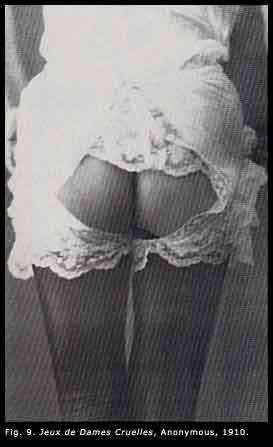 Witnessing
and analyzing Beatty’s radical shift from performance art to s/m
videos, I have myself often contemplated and experienced the status and
power of feminism. The question remains simple: Why is it that a discussion
of radical body art and sex work cannot be easily accommodated within
the postmodern feminist and gender discourses of art and academia? Why
is it that lesbian s/m cannot pass the judgment of patriarchal and liberal
thinkers? We need a new feminism, if one at all, which accomodates insurgent
sexual identities. In order to apply this statement to the case of Beatty,
let me first give a sketch of the artistic and political "feminist" movements
which informed her work. Beatty’s reputation as film producer and
director began with documentaries about performance art: the anthology
Sphinxes Without Secrets: Women Performance Artists Speak Out (1991);
The Sluts and Goddesses Video Workshop or How to Be A Sex Goddess in
101 Easy Steps (1992) in co-production with Annie Sprinkle; and Imaging
Her Erotics (1994) in co-production with Carolee Schneemann. It was
in the Fall of 1993 that Beatty first came out as an s/m performer and
sex worker. She had on several occasions interacted with the older artists
who had successfully turned their sex and body politics into "works of
art." Beatty’s struggle became to turn masochistic eroticism into
artistic property in the face of an "aging" performance art establishment.
Witnessing
and analyzing Beatty’s radical shift from performance art to s/m
videos, I have myself often contemplated and experienced the status and
power of feminism. The question remains simple: Why is it that a discussion
of radical body art and sex work cannot be easily accommodated within
the postmodern feminist and gender discourses of art and academia? Why
is it that lesbian s/m cannot pass the judgment of patriarchal and liberal
thinkers? We need a new feminism, if one at all, which accomodates insurgent
sexual identities. In order to apply this statement to the case of Beatty,
let me first give a sketch of the artistic and political "feminist" movements
which informed her work. Beatty’s reputation as film producer and
director began with documentaries about performance art: the anthology
Sphinxes Without Secrets: Women Performance Artists Speak Out (1991);
The Sluts and Goddesses Video Workshop or How to Be A Sex Goddess in
101 Easy Steps (1992) in co-production with Annie Sprinkle; and Imaging
Her Erotics (1994) in co-production with Carolee Schneemann. It was
in the Fall of 1993 that Beatty first came out as an s/m performer and
sex worker. She had on several occasions interacted with the older artists
who had successfully turned their sex and body politics into "works of
art." Beatty’s struggle became to turn masochistic eroticism into
artistic property in the face of an "aging" performance art establishment.
The performance art documentary Sphinxes Without Secrets was produced in response to the NEA controversies over the national funding of sexually explicit art. It brought together several performance artists such as Lenora Champagne, Ellie Covan, Diamanda Galas, Holly Hughes, and Laurie Anderson and intended to narrate a women's history of performance art to counter-act restrictive legislation and censorship. Beatty was appointed director of this gigantic project, which was made possible with major grants from New York State Council on the Arts, Art Matters, Inc., and DCTV. Beatty's interest in Sphinxes Without Secrets was to produce (rather than debate) sexual politics and to participate in culture wars against the American conservative climate. As producer and editor of Sphinxes Without Secrets and other independent videos, Beatty slowly started to turn the camera onto herself. She had her very first photo-shoot as "feminist porn activist" for the porn magazine Adam in 1993. The interview and photos were produced by Annie Sprinkle who (at that moment) praised her work highly: "Personally I think Maria Beatty is the best thing since Fellini, Jodorowsky and even Russ Meyer, and I'm lucky enough to be working with her." Beatty explained her commitment to alternative lesbian porn:
Mainstream porn just has the home video market. I've targeted a whole other area like festivals, galleries and universities ... I'm creating a whole new kind of distribution network for sexually explicit stuff. Plus, I have actually a whole new kind of freedom in terms of censorship. Because it's "art" and has "socially redeeming value", that gives me freedom to put all kinds of sex acts in my films that [mainstream] porn isn't legally able to.
Both Sprinkle and Beatty believed in the alternative distribution of lesbian pornography. However, a break occurred between them after the making of Sluts/Goddesses over Beatty's growing interest in s/m. In Sluts/Goddesses, Sprinkle and seven other "transformation facilitators" show a fantastic gamut of lesbian sex games from ancient sacred spirituality to dirty language and female ejaculation. The area of s/m role-play, however, did not get ample coverage in this humorous sex education program. Moreover, Whereas Sprinkle made a shift from porn star to artist-healer and cleverly commented on this shift in various publications, Beatty went in the exact opposite direction. She went underground because she wanted "to do the real thing" and at the same time started making enough money to fund an entire film making-process.
Beatty became a commercial s/m sex worker, amongst other things, in order to free herself from the strictures of government funding at a time when right-wing America started its capitalist tirade against "taxpayer funded homosexual pornography." Jesse Helm's proposed amendment to the Senate of that time intended to censor "indecent" art depicting "sadomasochism, homoeroticism, the exploitation of children and individuals engaged in sex acts." Helm's amendment, as well as feminist accusations of s/m, reflected a moral panic which Gayle Rubin predicted ten years earlier in her seminal essay "Thinking Sex: Notes for a Radical theory of the Politics of Sexuality" Rubin wrote:
"It is always risky to prophesy. But is does not take much prescience to detect potential moral panics in two current developments: the attacks on sadomasochists by a segment of the feminist movement, and the Right's increasing use of AIDS to incite virulent homophobia."
Rubin suggested that fringe sexualities be discussed outside the institutions and discourses of feminism in order to prevent the construction of a class of women "perverts." Nearly a decade later, in Presence and Desire: Essays on Gender,Sexuality and Performance, Jill Dolan continues to emphasize that a prevailing feminist anti-pornography rhetoric ultimately censors deeply layered erotic lesbian imagery. Dolan writes: "The Jesse Helmses of the United States aren't the only ones legislating representation from ideologically, morally, and ethically righteous positions." A contemporary writer, sex educator, and porn star, Carol Queen summarizes "feminism’s false analysis" of pornography in the British magazine Skin Two:
[Feminism] has made the mistake of overestimating its area of expertise, assuming that because it does good job in cultural and political analysis of gender, economics, and power, it can proceed to analyse everything, including sex ... Some women are deeply damaged by this absence of support. Others are simply turned off by feminism. For of course most of us do not eroticise spanking and other pervy joys out of any lack of self-worth ... How on earth can feminist (and others) imply our desire for pleasure is a source of weakness or worse?
Although theorists such as Gayle Rubin, Jill Dolan, Laura Kipnis, Julia Creet, and Elizabeth Grosz, have spoken out against the marginalization of s/m; this kind of sexuality is still predominantly viewed by feminism as one reminiscent of the symbolic father who objectifies and humiliates women and deprives them of a voice of resistance.
Beatty’s film art is incompatible with feminism because it encapsulates the return of "polymorphous perversity" in a new generation of female sex radicals who are unwilling to deal with the knowledge transfer ideologies of older generations. Beatty has felt a strong need to differentiate her work from her mentoral "feminist" artists. When Annie Sprinkle pronounced in an article for Spin Magazine: "I have no patience for beginners" (meaning incipient sex workers like Maria Beatty); Sprinkle became the Symbolic Mother who denied Beatty the right to explore her own fantasies. Both Sprinkle and Schneemann had previously blurred the boundaries between art, life and activism and diversified portraits of female sexuality in the arts and pornography. According to Beatty, these artists are stuck with the belief that the female body has to be worshipped, rather than mutilated, and they cannot conceive of the aesthetic or ideological functions of erotic violence.
If the postmodern art world has been fractured over the issue of erotic violence, is there any academic framework which can help us find continuity between generations of women artists? First of all, let us consider the canonical French feminist philosopher Luce Irigaray and her work Speculum of the other Woman. Irigaray argues that assertive female sexuality has been erased or misrepresented in the western philosophical tradition due to its being rooted in a Platonic illusionistic "stage setup." In an evocative reinterpretation of Plato’s myth of the cave, Irigaray points out that the spectator/reader of representation has to undergo a process of physical paralysis in order accept a de-materialized "purer" state of mind. Thus Irigaray imagines the prisoners in Plato’s cave as physically and mentally immobile and unable to envision the bodily, dark space, the womb from which they came: "Heads forward, eyes front, genitals aligned, fixed in a straight direction and always straining forwards, in a straight line." As for their erotic imagination, prisoners equally submit to a transition from materiality to representation. The cave as metaphor has emptied itself from any relation to the body, as she writes:
... man’s attributes figure only insofar as they have been made into statues, immortalized in deathly copies. Any reference that might have been made to it --if one could only turn around --is from the outset a formal one. The potency of the enchanter has always already been captured, made into a corpse by morphology.
It is Plato’s narrow theatrical agenda which performance artists and pornographers tried to overthrow in their attack on the abstract, gender-less ideas and shapes of academic theory and aesthetics. 60s and 70 performance artists attempted to "break the chains" of representation in order to make a new type of ritual body art. They paraded and appropriated the mythic functions and living properties of censored genital bodies in experimental performance works. Schneemann in Interior Scroll (1975) pulled a scroll out of her vagina and read aloud a text attacking a structuralist thinker who misread her body works. In 1991, Annie Sprinkle douched on stage in preparation of her "public cervix announcement" in which, aided by speculum and flashlight, she allowed audience members to look at her cervix.
Performance art’s assault on the philosopher's obsession with form and morphology, has to be reinvestigated in light of a new generation of s/m erotica artists. How does Beatty’s film art differ from performance art? How does the chained s/m performer conceive of sexuality in comparison to "liberated" transgressive transformation facilitators? Beatty is waging a new battle against restrictive stage settings imposed by art or pornography, yet she refuses to articulate the precise nature of her subversive ritual. Whereas the more established porn star Annie Sprinkle thrives on humorous and articulate commentaries to interrupt and enlighten happenings, Beatty hopes to rethink social and sexual freedom within the s/m mimetic scenario itself. Merging the body with cold technological environments, Beatty reclaims an artistic, women-friendly space for erotic cruelty inside the growing cultures, shapes and productions of lesbian s/m porn. Not unlike 60s and 70s performance artists, Beatty returns to a theory of bodily instincts, yet she easily appropriates the commodified styles of mainstream s/m and fetish pornography. Beatty’s porn aesthetics and tastes conflict with coarser and confrontational feminist movements. However, her super-sensualism is nurtured and understood by a new community of female sex workers, artists and critics. Writers such as Pat Califia and Kathy Acker circumvent restrictive legislation and cultivate violence on the body as a new setting for auto-ethnography and female pleasure. In Public Sex. The Culture of Radical Sex (1995) Pat Califia offers positive definitions of masochism, and cleverly comments on new materialist constructions of public sex in our culture. For instance, she describes how the s/m industry has started to use rubber and latex outfits to refine bondage fantasies. These costumes connote sexual preference and the s/m routine of transforming new materials and inventions for sexual fetishes: "The latex fetish is an excellent example of the way human culture (especially technology) alters human sexuality." Even if Califia's insights are considered to be "on the edge" of academic criticism, even if Beatty's fetishes do not qualify as aesthetic formal entities, both women teach us how s/m condenses aspects of female sexuality within the realm of altered languages and technology.
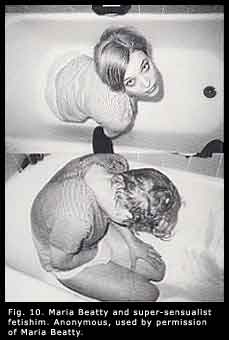 A
few sturdy feminist questions remain relevant to the altered bodily identities
of lesbian s/m. The first question is Irigaray's --whether the language
of the unconscious is gendered, whether the "representations" of bodily
desire carry a "male" or "female" morphology. This very same question
was raised by the older generation of performance artists when they fought
for the positive reinscription of women's bodies. Lesbian s/m is as concerned
with the female body, as it is with the positive reinscription and morphology
of pain. Before plunging into a discussion of the aesthetic of pain, let
us consider Irigaray's revision of Lacanian psycho-analysis and ask ourselves
whether or not Beatty's art speaks a gendered language. Irigaray endorses
Lacan's definition of the unconscious, yet ads a feminist twist. Speculum
of Another Woman investigates the morphology and new possibilities
of a feminine language. Metaphorically speaking, woman has to pass through
a looking-glass into a new territory of her own self-representation. The
speculum differs from the Platonic mirror in that woman is able to "self-touch"
and to mime hysteric modes of femininity. The speculum also develops a
body-to-body relationship between mother and daughter and thus overrides
Lacanian oedipal separation. Beatty's film The Elegant Spanking
dramatizes a mother-daughter separation as a romantic lesbian s/m fantasy
which turns mother’s punishment into gratification. The Black
Glove constructs a complex image of female castration. The film radically
confirms Beatty’s alienation, pain and fragmentation; yet the ending
suggests a pre-oedipal fantasy space which transcends genital organization
and includes the mother. In The black Glove, the symbolic mother
is shown as a shadow. In Beatty's forthcoming film Let the Punishment
Fit The Crime a more straightforward mother-daughter story comes to
light. This film is an example of masochist subversion in that "mother"
is represented as a staged, fetishistic subject; radiating the typical
attributes of high heels, mascara and lipstick looks. Beatty is the little
schoolgirl in love with her mother. She uses her mother's props to mutilate
a series of dolls; painting their eyes and genitals, sticking needles
and burning candle sticks into their helpless bodies in preparation of
a sacred offering. Like The Elegant Spanking, Beatty's gaze turns
the older woman into a desirable partner. She gets punished for her mutilations
through as an artful series of spankings, and all is well. The mother
caresses her behind with a soft powder puff, smokes a cigarette, and rescues
the daughter from humiliation and shame. In this last Beatty film, pain
again gets compensated for through lesbian love.
A
few sturdy feminist questions remain relevant to the altered bodily identities
of lesbian s/m. The first question is Irigaray's --whether the language
of the unconscious is gendered, whether the "representations" of bodily
desire carry a "male" or "female" morphology. This very same question
was raised by the older generation of performance artists when they fought
for the positive reinscription of women's bodies. Lesbian s/m is as concerned
with the female body, as it is with the positive reinscription and morphology
of pain. Before plunging into a discussion of the aesthetic of pain, let
us consider Irigaray's revision of Lacanian psycho-analysis and ask ourselves
whether or not Beatty's art speaks a gendered language. Irigaray endorses
Lacan's definition of the unconscious, yet ads a feminist twist. Speculum
of Another Woman investigates the morphology and new possibilities
of a feminine language. Metaphorically speaking, woman has to pass through
a looking-glass into a new territory of her own self-representation. The
speculum differs from the Platonic mirror in that woman is able to "self-touch"
and to mime hysteric modes of femininity. The speculum also develops a
body-to-body relationship between mother and daughter and thus overrides
Lacanian oedipal separation. Beatty's film The Elegant Spanking
dramatizes a mother-daughter separation as a romantic lesbian s/m fantasy
which turns mother’s punishment into gratification. The Black
Glove constructs a complex image of female castration. The film radically
confirms Beatty’s alienation, pain and fragmentation; yet the ending
suggests a pre-oedipal fantasy space which transcends genital organization
and includes the mother. In The black Glove, the symbolic mother
is shown as a shadow. In Beatty's forthcoming film Let the Punishment
Fit The Crime a more straightforward mother-daughter story comes to
light. This film is an example of masochist subversion in that "mother"
is represented as a staged, fetishistic subject; radiating the typical
attributes of high heels, mascara and lipstick looks. Beatty is the little
schoolgirl in love with her mother. She uses her mother's props to mutilate
a series of dolls; painting their eyes and genitals, sticking needles
and burning candle sticks into their helpless bodies in preparation of
a sacred offering. Like The Elegant Spanking, Beatty's gaze turns
the older woman into a desirable partner. She gets punished for her mutilations
through as an artful series of spankings, and all is well. The mother
caresses her behind with a soft powder puff, smokes a cigarette, and rescues
the daughter from humiliation and shame. In this last Beatty film, pain
again gets compensated for through lesbian love.
Elizabeth Grosz’ writings on deviant sexualities provide a useful ending to the essay as they provide insights into the delicate subject of erotic violence and pain, a new topic for feminists to consider. First of all, lesbian s/m could be approached as an instance of the post-gender bodily identity. In Volatile Bodies, Grosz ventures to redefine the body using Deleuze's essay "Desiring Machines" from Anti-Oedipus. The body becomes a desiring machine when it de-humanizes the object of desire and dissolves into surrounding technological environments. The subject becomes one with the machine-like apparatus and senses its merging components as changing, segmented and discontinuous waves, flows, intensities. According to Grosz, Deleuzian feminism flattens out the relation between the social and psychical into a gender-neutral or gender-bending concept of the "desiring machine." Instead of aligning desire with the realm of fantasy and opposing it to the real, the machine stands for positive actualizations of the body within new technological environments. The desiring machine becomes a masochistic body as it stops functioning as an organic, gendered unit. The body is subject to cold, intricate surgical practices; and gives up the age-old distinction between the "inner" and "outer" human being. Although we see a movement towards coldness in Beatty's work, her body also craves to give up its position of isolation and to recover awareness through sensations of heat and loving.
Grosz refines her theory of desire and confronts the issue of pain in the essay "Animal Sex: Libido as Desire and Death." She argues that desire exhibits a logic of its own and always insists on a certain formlessness and indeterminacy. Grosz refers to the work of Alfonso Lingis to redefine the connections between sexual pleasure and death. Lingis distinguishes between corporeal need and erotic desire, and explains that the latter craves strategies of "pleasurable torment" in order to prolong and extend beyond physiological needs. Desire fragments and dissolves the unity and utility of the organic body and break ups the teleological plans and tasks to perform. As we have seen in the discussion of Genet's The Balcony, the function of the "other" in eroticism is to interrupt the subject's goal-oriented approch to sex and to enter the body as an open-ended and performative category. Following Lingis, Grosz explains that the other deranges the physical order and industry of the subject. The body get thoroughly confused as it is approached through diverse organs, zones, surfaces which are jealous of one another and want to get aroused "...not simply by pleasure, through caresses, but also through the force and energy of pain. Pain is as capable, perhaps more so, of inscribing bodies as pleasure. We cannot readily differentiate the processes by which pleasurable intensities are engendered from those by which painful intensity is produced (my italics)" Grosz goes on to explain that erotogenic zones are not necessarily nostalgic reminiscences of a pre-oedipal, infantile bodily organization; but they are sites-in-construction " ... in the process being produced, renewed, transformed through experimentation, practices. innovations, the accidents or contingencies of life itself, the coming together of surfaces, incisive practices, inscriptions. In order to accept pain as a powerful category of inscription and intensification, Grosz argues, the Freudian "hydraulic" model of sexual release, and the internally interlinked faculties of pleasure and death, need to be revised. The needs and functions of the body operate differently from the law of desire.
Beatty's films portray pain as a principal agent of the law of desire. In this respect, perhaps, one should never consider her films as a finished work of art. Whether the films document an ongoing, infantile or matured "feminist" search for ego, a psychological or linguistic reiteration of childhood trauma, a healthy or destructive exploration of erotogenic zones; her masochistic art shapes our understanding of a societal trend towards s/m sexuality and cries out for female desire within a new (post)feminist movement.
I would like to thank Maria Beatty for her love and support. Mistresses Diva, Carrie, Midori, and Ava Taurel for their explanations and contributions to the forthcoming book The Beatty Parlor. Joseph "Joe" Schaub for his ample feedback from the outset of the project. Herbert Blau and Kathleen Woodward at the Center for Twentieth Century Studies for their enthousiasm and encouragement. Matthew Causey for sharing lengthy conversations in Milwaukee during the Summer of 1996, when I started to write the essay. Azhar Tyabji for helpful comments on an earlier draft.

